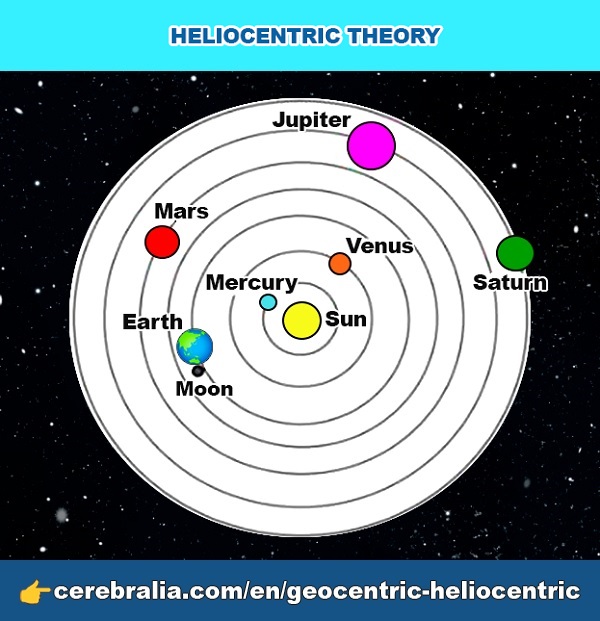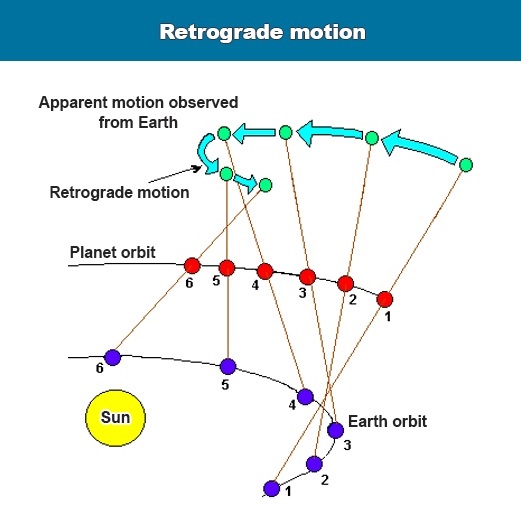Share on:
The Geocentric model
For thousands of years humans have tried to make sense of the skies above. When gazing up at the night sky and witnessing the stars and planets move across the sky we can understand why the ancient people adopted the geocentric view of the universe.

The ancient Greeks were the first to suggest a geocentric view of the universe. They believed that the Earth was at the center with the celestial bodies rotating around it in a series of layered spheres.
To Plato the Universe was perfect and unchanging. Stars were eternal and divine, embedded in an outer sphere. All heavenly motions were circular or spherical as the sphere was the perfect shape.
Aristotle's own model of the Universe had a series of 53 concentric, crystalline, transparent spheres rotating on different axes. Each sphere was centered on a stationary Earth. Stars were fixed on the outer sphere. The Moon marked the boundary between the unchanging, constant heavens and the corruptible Earth.

In the Ptolemaic system each planet revolves uniformly along a circular path (epicycle), the centre of which revolves around Earth along a larger circular path (deferent). Ptolemy enhanced the effect of eccentricity by making the epicycle’s centre sweep out equal angles along the deferent in equal times as seen from a point that he called the equant. The centre of the deferent was located midway between the equant and Earth.
In Ptolemy's geocentric model of the universe, the Sun, the Moon, and each planet orbit a stationary Earth. For the Greeks, heavenly bodies must move in perfect circles. In order to retain such motion and still explain the erratic apparent paths of the bodies, Ptolemy shifted the centre of each body's orbit (deferent) from Earth—accounting for the body's apogee and perigee—and added a second orbital motion (epicycle) to explain retrograde motion. The equant is the point from which each body sweeps out equal angles along the deferent in equal times. The centre of the deferent is midway between the equant and Earth.

The Ptolemaic model did a good job of explaining and predicting planetary positions. However, small discrepancies between the predicted and observed positions of the planets arose. People found that additional small epicycles would bring predictions back into alignment with observations.
But after 1500 years, the number of necessary refining epicycles exceeded a hundred. Unfortunately, the epicycles made the new geocentric model incredibly complicated. To some, the increasing complexity of the Ptolemaic model argued against it being true.
The Heliocentric model
The theory that the Earth revolves around the Sun is called the heliocentric theory, helio meaning «sun» and centric meaning «at the center». So, heliocentric means «the Sun at the center of the universe.» This theory was once thought of as eccentric and even heretical.
The Copernican heliocentric model was the first widely accepted idea that the sun was the center of the solar system, rather than Earth. However, Nicolaus Copernicus wasn't the first person to suggest this.
Aristarchus of Samos (310 BC– 230 BC) was an ancient Greek astronomer and mathematician who presented the first known heliocentric model that placed the Sun at the center of the known universe, with the Earth revolving around the Sun. However his astronomical ideas were rejected in favor of the geocentric theories of Aristotle and Ptolemy.
Nicolas Copernicus
Nicolaus Copernicus: (1473–1543) was a polish astronomer who proposed the heliocentric system. It positioned the sun at the center of the universe, motionless, with Earth and the other planets rotating around it in circular paths and at uniform speeds.
Copernicus' theory marks the beginning of the shift away from a geocentric universe with Earth at its center. Copernicus held that Earth is another planet revolving around the fixed sun once a year, and turning on its axis once a day.

The ordering of the planets known to Copernicus were in the following order from the Sun: Mercury, Venus, Earth, Mars, Jupiter, and Saturn. All of these ideas were presented in «On the Revolutions of the Heavenly Spheres», a work of six volumes. Shortly before his death, Copernicus published his work. Copernicus' work attracted much attention.
Copernicus explained retrograde motion with the heliocentric theory. Retrograde motion was simply a perspective effect caused when Earth passes a slower moving outer planet that makes the planet appear to be moving backwards relative to the background stars. The further away the planet is, the smaller this effect becomes.

Copernicus most important contribution was to use observational data to work out the true orbital periods (sidereal periods) and relative sizes of the planetary orbits within the heliocentric model. Apparently, no one had done this before, and this information was key in making further improvements to the heliocentric model.
Galileo Galilei
Galileo Galilei was an Italian astronomer who is known as the «father of modern observational astronomy.» He designed his own telescope, which he had improved to 30x magnification. Using this new instrument, Galileo made a number of astronomical observations, which he published in the Sidereus Nuncius in 1610.
Galileo presented arguments favoring the heliocentric theory of Copernicus. He is considered to be the first scientist to make thorough observations of the sky. With his telescope, Galileo discovered that the Milky Way consists of countless stars rather than the misty band you can see with the naked eye.
He described the surface of the moon as rough, uneven, and imperfect. His observations challenged Aristotle's claim that the moon was a perfect sphere, and the larger idea that the heavens were perfect and unchanging.
While observing Jupiter over the course of several days, he discovered that Jupiter possessed four large satellites which were later called the Galilean Moons. This discovery supported Copernican cosmology, which stated that Earth is a planet like all others.

In 1610, Galileo also observed that Venus had a full set of phases, similar to the phases of the moon, that we can observe from Earth. This was explainable by the Copernican system, which said that all phases of Venus would be visible due to the nature of its orbit around the sun.

Galileo also observed sunspots moving across the Sun's surface and he deduced that the Sun was rotating around its own axis carrying around the sunspots in its rotation.
Galileo had concluded that the Copernican model of the universe was correct. In 1632, he published his book «Dialogue Concerning the Two Chief World Systems» which put forth the theory that the Earth revolves around the Sun, it was a direct challenge to the prevailing belief that the Earth is the center of the universe.
Johannes Kepler
Johannes Kepler (1571–1630) was a German scientist who was the first to openly endorse Copernican cosmology. In 1600, Kepler set to work on the orbit of Mars, the second most eccentric of the six planets known at that time. This work was the basis of his book, the Astronomia nova (1609).
The book argued heliocentrism and ellipses for planetary orbits, instead of circles modified by epicycles. It contains the first two laws of planetary motion (in 1619, the third law was published). The laws state the following:
- All planets move in elliptical orbits, with the sun at one focus.
- A line that connects a planet to the sun sweeps out equal areas in equal times.
- The time required for a planet to orbit the sun, called its period, is proportional to long axis of the ellipse raised to the 3/2 power. The constant of proportionality is the same for all the planets.
Isaac Newton
Isaac Newton (1642–1727) developed further ties between physics and astronomy through his law of universal gravitation. Realizing that the same force that attracted objects to the surface of Earth held the moon in orbit around the Earth, Newton was able to explain, in one theoretical framework, all known gravitational phenomena.
Newton's Principia (1687) formulated the laws of motion and universal gravitation. His laws of motion were to be the solid foundation of mechanics; his law of universal gravitation combined terrestrial and celestial mechanics into one great system that seemed to be able to describe the whole world in mathematical formulae.
By the time of Newton, most people in the West had become convinced of heliocentrism, and Newton's work seemed to put last nails in the coffin of geocentrism.
How big is our universe?
With the observations of others, astronomers came to accept that the Sun is not at the center of the universe. The Sun is only at the center of our solar system. The universe is much larger than just the solar system.

Edwin Hubble, for whom the Hubble Space Telescope is named, was one of the leading astronomers of the twentieth century. His discovery in the 1920s that countless galaxies exist beyond our own Milky Way galaxy revolutionized our understanding of the universe and our place within it.
Geocentric & Heliocentric Model Quiz

🥇 Find out more:
✅ Why do we see objects in color?
✅ Why is snow white when ice is transparent?
🥇 Movie review & film summary:
✅ Paradise: selling our age in exchange for money
✅ Oppenheimer: about the father of the atomic bomb
✅ The Pope's exorcist: based on the life of the chief Vatican exorcist
✅ Radioactive: tells the story of Marie Curie, a two-time Nobel Prize winner

